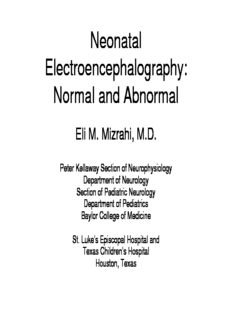
Neonatal Electroencephalography: Normal and Abnormal PDF
Preview Neonatal Electroencephalography: Normal and Abnormal
Neonatal Electroencephalography: Normal and Abnormal Eli M. Mizrahi, M.D. Peter Kellaway Section of Neurophysiology Department of Neurology Section of Pediatric Neurology Department of Pediatrics Baylor College of Medicine St. Luke’s Episcopal Hospital and Texas Children’s Hospital Houston, Texas Learning Objectives • Understand the clinical utility of neonatal electroencephalography • Recognize normal developmental features of neonatal EEG • Recognize abnormal features of neonatal EEG and their clinical implications • Recognize electrographic seizure discharges Disclosure Statement • Grant and Research Support – National Institutes of Health, Bethesda, MD, USA – NeuroPace, Inc., Palo Alto, CA, USA • Speaker’s Bureau – None • Consultant – Michael E. DeBakey Veteran’s Affairs Medical Center, Houston, TX, USA – SleepMed/Digitrace Care Services, Houston, TX, USA • Major Stock Shareholder – None • Other Financial/Material Support – None Colette Dreyfus-Brisac 1916-2006 Neurological and Electroencephalographic Correlative Studies in Infancy. Kellaway, P and Petersen, I (eds). Grune & Stranton, New York, 1964: 186-207. A conference and symposium sponsored by the World Federation of Neurology, Baylor College Medicine, NIH and Houston Endowment, October 2-3, 1963, Houston, TX. EEG in Assessment of the Neonate • General considerations – Role of EEG relative to other testing modalities – Technical considerations – Issues in interpretation • Features of the normal and abnormal neonatal EEG • Application to specific clinical problems Neonatal EEG Best Utilized as a Correlative Study • Infant’s medical history • Recording strategies based upon history and physical findings • Clinical observation and stimulation during recording • Relationship of EEG findings to other laboratory findings • Consultation between neonatologist and neurophysiologist Application of Neonatal EEG in Consideration of Clinical Questions • Determination of conceptional age • Assessment of diffuse brain injury – Assessment of presence of brain death • Assessment of focal brain injury • Determination of timing of brain injury • Determination of prognosis • Diagnosis of neonatal seizures Technical Considerations • Electrode application • EEG channel selection • Polygraphic channels – Respirations – Electrocardiogram – Electro-oculogram – Electromyogram Recording Strategies • Montage selection – Single montage – Inclusion of Cz and other midline regions • Recording duration • Recording protocol – Wake/sleep cycles – Suspected abnormal clinical events Basis for Interpretation • The normal neonatal EEG undergoes rapid and predictable changes as a consequence of brain growth and development. • Abnormalities may be characterized by altered developmental characteristics as well as specific patterns or wave-forms. • Patterns that are normal at one development stage may be abnormal at another.
Description: